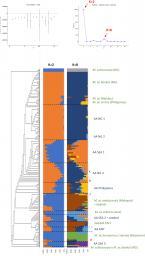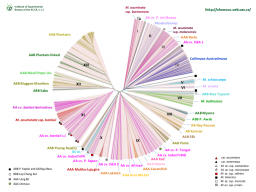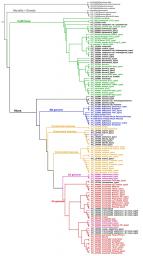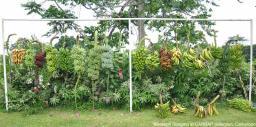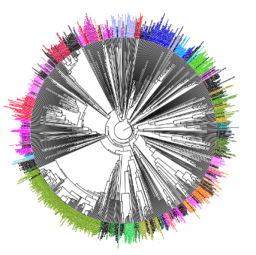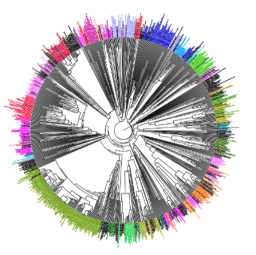List of genotyping studies stored in MGIS
Hybridization and introgressions are important evolutionary forces in plants. They contribute to the domestication of many species, including understudied clonal crops. Here, we examine their role in the domestication of a clonal crop of outmost importance, banana (Musa ssp.). We used genome-wide SNPs generated for 154 diploid banana cultivars and 68 samples of the wild M. acuminata to estimate and geo-localize the contribution of the different subspecies of M. acuminata to cultivated banana. We further investigated the wild to domesticate transition in New Guinea, an important domestication center. We found high levels of admixture in many cultivars and confirmed the existence of unknown wild ancestors with unequal contributions to cultivated diploid. In New Guinea, cultivated accessions exhibited higher diversity than their direct wild ancestor, the latter recovering from a bottleneck. Introgressions, balancing selection and positive selection were identified as important mechanisms for banana domestication. Our results shed new lights on the radiation of M. acuminata subspecies and on how they shaped banana domestication. They point candidate regions of origin for two unknown ancestors and suggest another contributor in New Guinea. This work feed research on the evolution of clonal crops and has direct implications for conservation, collection, and breeding.
In this study, Christelová et al (2016) summarized the results of systematic cytological and molecular characterization of the Musa ITC collection. By December 2015, 630 accessions have been genotyped. The SSR markers confirmed the previous morphological based classification for 84% of ITC accessions analyzed.
In this work, Čížková et al, (2015) examined nuclear DNA content and genomic distribution of 45S and 5S rDNA in 21 diploid accessions recently added to ITC collection, representing both sections of the genus Musa. Sequence analysis of ITS region provides further information about evolutionary relationships between individual accessions and suggested that some of analyzed accessions were interspecific hybrids and/or backcross progeny.
In this study, Li et al (2010) obtained nuclear ribosomal ITS and chloroplast (atpB-rbcL, rps16, and trnL-F) DNA sequences of 36 species (42 accessions of ingroups representing three genera) together with 10 accessions of ingroups retrieved from GenBank database and 4 accessions of outgroups, to construct the phylogeny of the family, with a special reference to the infrageneric classification of the genus Musa. The phylogenetic analyses elaborated previous results in supporting the monophyly of the family and suggested that Musella and Ensete may be congeneric or at least closely related, but refuted the previous infrageneric classification of Musa.
Sardos et al (2016) published a large panel of 575 accessions, 94 wild relatives and 481 cultivated accessions belonging to the section Musa that were analyzed with a set of 498 DArT markers. DArT has been a successful and accurate method to describe Musa diversity and help in the resolution of cultivated banana genome constitution and taxonomy, and highlight discrepancies.
In this study, Sardos et al (2016) describe Genome Wide Association analyses on 105 diploid banana accessions from the Musa acuminata species, using genotyping-by-sequencing to track down SNP markers with potential ties to domestication-related banana features such as seedlessness and sterility. The results presented in PLOS ONE confirm the feasibility and potential of GWAS. The researchers are already making plans to explore the genetics of drought tolerance and disease resistance, traits that are important to banana farmers, and by extension to breeders.
The TRC is a set of 34 accessions representative of the overall banana diversity that were selected by a panel of experts to be used as references and standards for the characterization and identification of Musa accessions (cultivated and closed relatives). Currently, the TRC is being characterized in 12 partner collections and is used to test the robustness of standard descriptors across environments.
In this study, Christelová et al (2011) analysed 171 triploids accession with 19 SSR markers at the Musa Genotyping Centre. The Musa Genotyping Centre was established at the Laboratory of Molecular Cytogenetics and Cytometry of the Institute of Experimental Botany (IEB), Olomouc, Czech Republic in 2009. A standardized platform for molecular characterization has been developed for Musa germplasm (Christelová et al. 2011). The system is based on 19 microsatellite loci that are scored after the PCR with fluorescently labeled primers and capillary electrophoretic separation with internal standard.
In this study, Christelová et al (2011) analysed 221 diploids accession with 19 SSR markers at the Musa Genotyping Centre. The Musa Genotyping Centre was established at the Laboratory of Molecular Cytogenetics and Cytometry of the Institute of Experimental Botany (IEB), Olomouc, Czech Republic in 2009. A standardized platform for molecular characterization has been developed for Musa germplasm (Christelová et al. 2011). The system is based on 19 microsatellite loci that are scored after the PCR with fluorescently labeled primers and capillary electrophoretic separation with internal standard.

